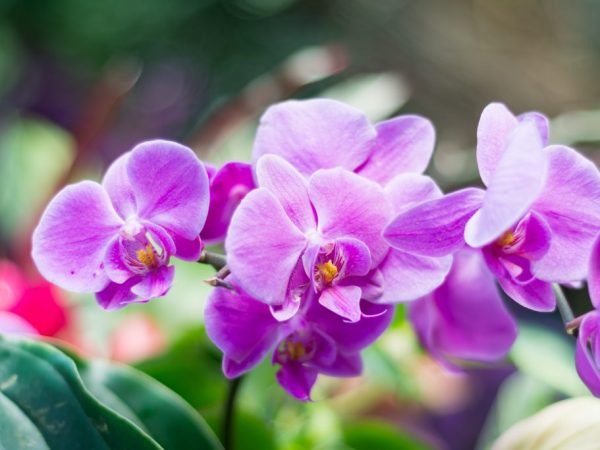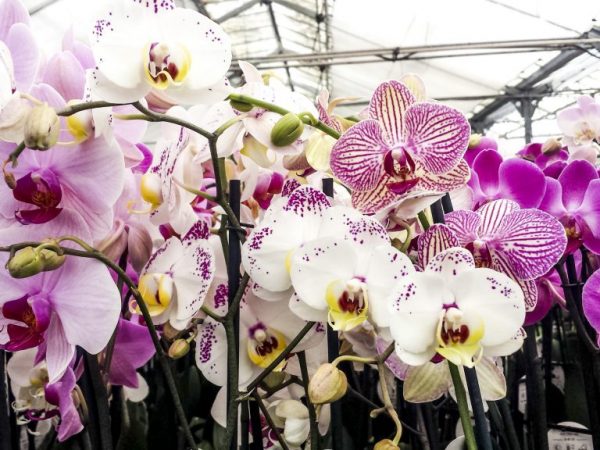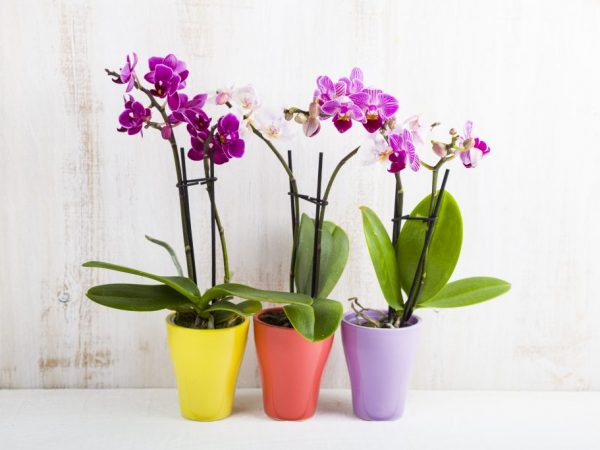The difference between orchids and phalaenopsis
Orchid and Phalaenopsis are popular and common plants among gardeners. These are beautiful decorative flowers that grow for a long time with proper care. What is the difference between Orchids and Phalaenopsis, not everyone knows, because the plants belong to the same group. The second option is suitable for novice florists, and the first for more experienced ones.

The difference between orchids and phalaenopsis
Description of Orchids
All plants that belong to the orchid family are called Orchids. It is an advanced flower species that includes many subspecies. Orchids have existed since the early stages of plant evolution.
They include:
- 5 subfamilies;
- more than 20 tribes;
- more than 60 subtribs.
Orchids are a diverse family of flowers. There are more than 70 00 of them.
The natural environment of orchids is tropical forests. A humid and warm climate is ideal for them. Among the numerous subspecies, there are also those for which more comfortable conditions in the middle climatic zone. The family is distributed in all parts of the planet, except for Antarctica.
Due to the huge number of subspecies, it is difficult to single out the exact characteristics of the Orchids. The main features are their unique biological structures. The filaments of stamens in flowers are fused, which is not found in other plants.
Also the difference is the way of pollination. If most flowers are characterized by the spread of pollen through the air, then Orchids are pollinated by insects.

The orchid includes many subspecies
Description of Phalaenopsis
The plant belongs to the orchid varieties. The natural habitat of the Phalaenopsis genus is warm forests with high levels of humidity. The flower grows both in the highlands and in the plains.
The variety includes more than 40 types of flowers. The characteristic features are wide leaves and a relatively short stem, as well as the presence of aerial roots. Phalaenopsis growth is always upward.
An adult plant has 4-5 leaves, the length of which is 25-35 cm. The shade of the foliage does not change for 12 months. Color may vary depending on species and conditions.
The flower looks like the wings of a butterfly. It has a pleasant and strong aroma. They have long peduncles in which branches are often formed. The Decorum company calls Phalaenopsis the best for growing at home.
Differences
Orchid and Phalaenopsis mean different things. The first term refers to a family of plants, and the second is the name of a particular species that belongs to it. Phalaenopolis includes several dozen types of flowers, all of which are of the orchid type.
Both plants are characterized by:
- long leaves;
- unpretentiousness to the conditions of the content;
- accumulation of moisture in foliage;
- the need for watering by immersion;
- exactingness to lighting;
- the need for fertilizers with substrates.

The orchid belongs to the plant family, and the phalaenopsis is a separate species
The parameters by which the orchid differs from the phalaenopsis:
- Flowers. If all types that belong to the family have different sizes of flowers, then Phalaenopsis has only large ones.
- Leaves.The subspecies are characterized by semicircular leaf tips, while most have pointed ones.
- Priming. Most flowers grow in heavy soil, while Phylenopsis prefer lighter soil.
- Temperature. For the normal development of orchids, temperature drops are required, while Phylenopsis grow without them.
- The number of blooms. The genus is characterized by flowering more than 1 time per year.
- Way of development. If orchids are terrestrial flowers, then their subspecies is an epiphyte flower.
Additionally, you can distinguish by the effect on them of direct sunlight best. Phylenopsis tolerate them well, but most other types do not. The subspecies also has a characteristic monopodial growth, the absence of tuberidia and the need for more moisture.
The difference between orchids and phalaenopsis is also the prevalence around the planet. If the whole family is spread everywhere, except for the coldest parts of the Earth, then Phylenopsis are found in nature only on 2 continents. They are also less whimsical than other subspecies.
Conclusion
Both types are well suited for growing on a windowsill and, with proper and timely care, will delight with beautiful flowering. It is necessary to irrigate regularly and maintain all the necessary conditions in the room. To successfully grow both types, you need to properly plant. It is also necessary to carefully select the soil.


